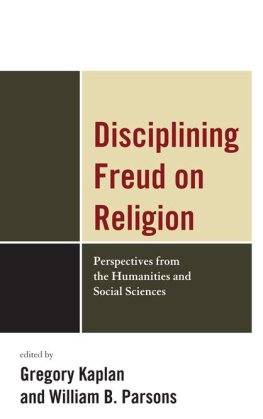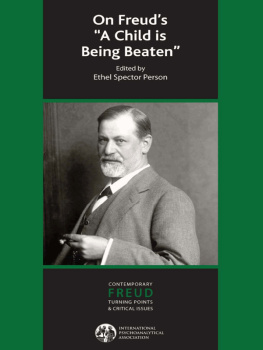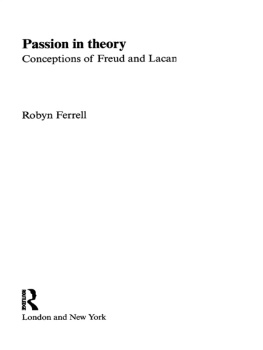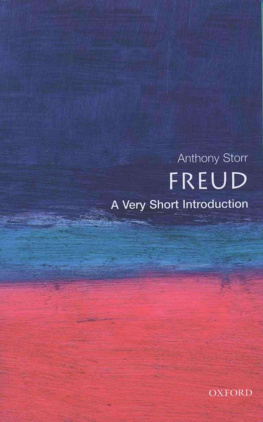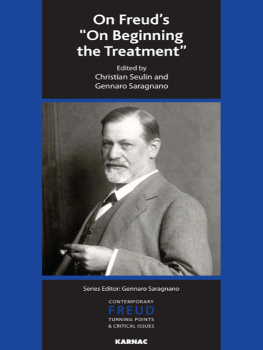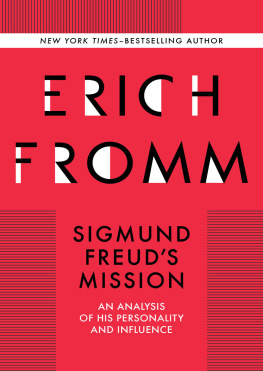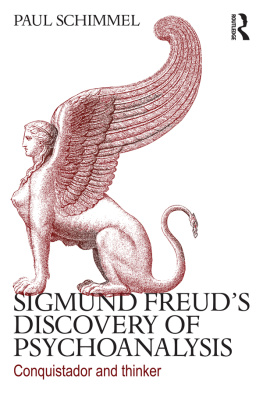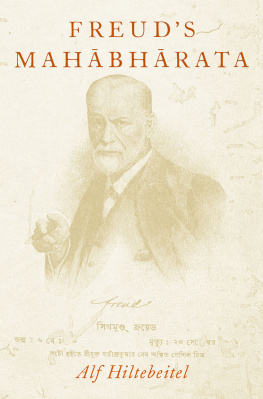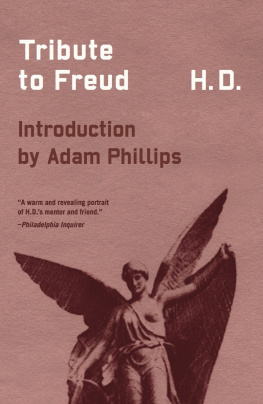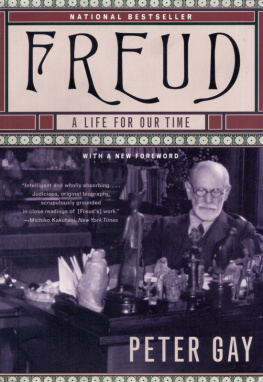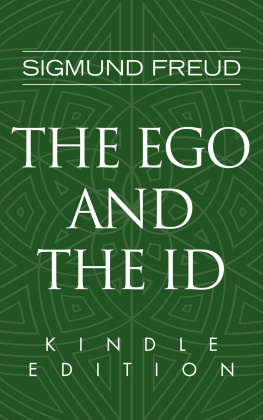The Letters of
Sigmund Freud and Otto Rank

The Letters of Sigmund Freud & Otto Rank
Inside Psychoanalysis
Edited by
E. James Lieberman, M.D.
Robert Kramer, Ph.D.
Letters translated by
Gregory C. Richter

2012 The Johns Hopkins University Press
All rights reserved. Published 2012
Printed in the United States of America on acid-free paper
2 4 6 8 9 7 5 3 1
Published by arrangement with the Estate of Otto Rank and The Trustees of
Columbia University in the City of New York.
For the Sigmund Freud Letters
A. W. Freud et al. (2012)
The Johns Hopkins University Press
2715 North Charles Street
Baltimore, Maryland 21218-4363
www.press.jhu.edu
Library of Congress Cataloging-in-Publication Data
Freud, Sigmund, 18561939.
[Correspondence. English. Selections]
The letters of Sigmund Freud and Otto Rank : inside psychoanalysis/
edited by E. James Lieberman and Robert Kramer ;
letters translated by Gregory C. Richter.
p. ; cm.
Includes bibliographical references and index.
ISBN -13: 978-1-4214-0354-0 (hardcover : alk. paper)
ISBN -10: 1-4214-0354-4 (hardcover : alk. paper)
1. Freud, Sigmund, 18561939Correspondence. 2. Rank, Otto,
18841939 Correspondence. 3. PsychoanalystsAustriaCorrespondence.
4. Psychoanalysis. I. Lieberman, E. James, 1934 II. Kramer, Robert, 1953 III. Title.
[ DNLM: 1. Freud, Sigmund, 18561939. 2. Rank, Otto, 18841939. 3. Psychoanalytic
TheoryCollected Correspondence. 4. History, 19th Century. 5. History, 20th Century.
6. Psychoanalysishistory. WM 460]
BF 173. F 85 A 4 2012
150.1952092dc23
[ B ] 2011016274
A catalog record for this book is available from the British Library.
Frontispiece: The Committee, 1922. Seated: Freud, Ferenczi, Sachs; standing: Rank, Abraham,
Eitingon, Jones. Guiding the movement from 1913, members in each location sent letters
to the other locations: Vienna, Budapest, Berlin, London. All were physicians except Rank
and Sachs; all were Jewish except Jones. Courtesy of the estate of A. W. Freud et al., by
arrangement with Paterson Marsh Ltd., London
Special discounts are available for bulk purchases of this book. For more information,
please contact Special Sales at 410-516-6936 or specialsales@press.jhu.edu.
The Johns Hopkins University Press uses environmentally friendly book materials, including
recycled text paper that is composed of at least 30 percent
post-consumer waste, whenever possible.
Contents
Preface
Newly available unpublished letters shed light on the remarkable professional and personal relationship between Sigmund Freud and his youngest colleague, Otto Rank. The two lived near each other in Vienna during the formative years of psychoanalysis, from 1906 to 1926. This volume presents some two hundred fifty letters (most written when one or both men were away from home) within a narrative that provides historical and psychoanalytic context for general readers as well as specialists. The letters add a missing piece to the biographies of these men and to the history of an idea that held sway for much of the last century in Westernand globalthought and culture. The psychoanalytic movement had, and still has, an impact beyond psychology, psychiatry, and anthropologyin literature, philosophy, art, religion, entertainment, marketing, and politics.
Sigmund Freud wrote about twenty thousand letters in his lifetime of 83 years (18561939) and received just as many himself. He kept a log of mail sent and received from hundreds of correspondents. Freud spent most evenings writing thoughtful, often elegant, letters by hand (his angular Frakturschrift can be read today only by specialists). A superb speaker and writer in his native language, he learned Latin and Greek, Italian, some Hebrew, enough Spanish to read Cervantes, enough French to work with Charcot and translate a book on hypnosis, and enough Englishhis favoriteto translate John Stuart Mills On Liberty and to analyze British and American patients. He corresponded in fluent English with Ernest Jones, whose German was limited.
Rank, 28 years younger than his mentor, wrote in modern script. Trained as a locksmith, he enjoyed technology; he fixed things, typed, drove a car, and
Freuds family lived in an apartment (also his office) on Berggasse (Hill Street) from 1891 to 1938. He often worked 16 hours a day, beginning at 8 A.M. and ending between midnight and 3 A.M. , with evening hours devoted to correspondence, reading, and writing. His wife, Martha, entertained often, mostly upper-middle-class Jewish friends, Freuds colleagues, and some patients. Rank routinely dined there before the Wednesday meetings of the psychoanalytic group. Martha had, besides her unmarried sister, Minna Bernays, five helpers: a maid (Paula Fichtl, who also received Freuds patients), a cook, a governess for the older children and a nanny for the younger, and a charwoman. Punctuality was important, something then unknown in leisurely Vienna. There was never any waiting for meals: at the stroke of one [main meal] everybody in the household was seated at the long dining-room table and at the same moment one door opened to let the maid enter with the soup while another door opened to allow my father to walk in from his study to take his place at the head of the table facing my mother at the other end.
As secretary of the Vienna Psychoanalytic Society, Rank kept the Minutes. Later he headed the Verlag (publishing house) and coauthored the Vienna Rundbriefe (circular letters) to Committee members in Budapest, Berlin, and London. Freud, about 5 7, had his hair and beard trimmed daily at the barbers, posed for portraits, and imagined his bust on display at the University of Vienna. Rank, a few inches shorter and rather homely, nevertheless had three attractive women in his life: his two wives and Anas Nin.
The Freud-Rank letters do more than fill a gap in the history of psychoanalytic theory, practice, and organization. They dramatically reveal the interplay of personality and profession, theory and practice. From a father-son and teacher-pupil beginning, the two men become colleagues. The letters provide access to their work, family, travels, humor, anger, pathos, friends and rivals, sickness and health. This mentorship is insufficiently appreciated because of its ending, with Rank excommunicated from the organizations and texts of psychoanalysis during its heyday. The mentorship brings to mind that of Plato and Aristotle (well known to our principals), where the best pupil became a formidable critic.
One of the most influential thinkers of the twentieth century, Freud is the subject of more biographies than anyone can digest. The most influential is The Life and Work of Sigmund Freud, by Ernest Jones, in three large volumes (1953, 1955, 1957), with at least 14 printings, a one-volume abridgment, and many translations. Jones knew both Freud and Rank for 30 years and had access to Freud letters only published in full after 1990. Joness partisan view of rivals Ferenczi and Rank becomes clear in our volume, which helps balance the record.
Freuds papers reside in the Library of Congress in Washington, D.C. Some items have only recently been opened to researchers, and some remain closed for years, even decades. Ranks papers, including originals of Freuds letters and some manuscripts, are at Columbia University, open to scholars. Most of Ranks letters to Freud came to Dr. Judith Dupont in Paris from the late Michael Balint, student and friend of Sndor Ferenczi. We assume that Freud gave the Rank letters to Ferenczi.
Next page

